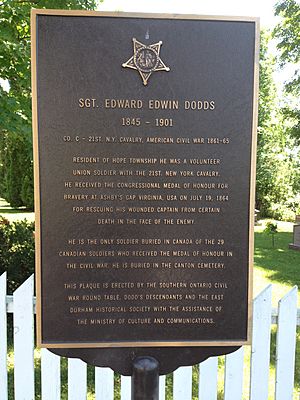Edward E. Dodds facts for kids
Quick facts for kids
Edward Edwin Dodds
|
|
|---|---|
| Born | 1845 Port Hope, Ontario |
| Died | January 12, 1901 |
| Buried |
Canton Cemetery
|
| Allegiance | |
| Service/ |
|
| Years of service | 1863 - 1865 |
| Rank | Sergeant |
| Unit | |
| Awards | |
Edward Edwin Dodds (born 1845, died January 12, 1901) was a brave soldier from Canada. He fought for the Union Army during the American Civil War. He was part of the 21st New York Cavalry.
Dodds received the Medal of Honor. This is the highest award for bravery in the United States. He earned it for his actions at Ashbys Gap, Virginia, on July 19, 1864. He received the award on June 11, 1896.
Early Life
Edward Edwin Dodds was born in 1845. His birthplace was near Port Hope, Ontario, Canada. His parents were Thomas and Sarah Dodd.
Serving in the Civil War
When he was 21, Edward Dodds joined the army. He signed up for three years of service in the American Civil War. He joined in Rochester, New York on July 31, 1863. On August 28, he officially became a private. He served in Company C of the 21st New York Volunteer Cavalry. This unit was also called the Griswold Light Cavalry.
Dodds was promoted to sergeant on May 1, 1864. He was later wounded in a battle. This happened at Bolivar Heights, near Harpers Ferry, Virginia.
Bravery at Ashby's Gap
On July 19, 1864, Sergeant Dodds joined his regiment. They were fighting at Ashby Gap, Virginia. This was a small battle. Union cavalry tried to cross the gap. Their goal was to stop the Confederate army. They wanted to attack supply trains.
During the fight, a Union captain was in danger. He fell wounded and could have been captured. Sergeant Dodds bravely rescued him. He did this while under heavy enemy fire. He moved the captain to a safe area.
A newspaper letter from 1896 shared more details. It said the 21st New York Cavalry met the enemy. The enemy opened fire. The Union soldiers were outnumbered and had to retreat.
The captain of Company C was badly wounded. His horse was killed. He could not get free. Sergeant Dodds got off his own horse. Bullets were flying everywhere. He helped his captain get free. Then he helped the captain onto his own horse. Dodds also got back on his horse.
The enemy had moved behind them. When Dodds reached the river crossing, it was blocked. But he did not give up. He rode along the riverbank. He found a good spot. Then he jumped his horse into the river. He swam across under fire. He reached the Union lines safely with his captain. The captain later recovered. He told the War Department about Dodds' bravery.
This was just one example of Dodds' courage. He was later badly wounded in his right arm. His arm had to be removed at the shoulder. He spent time in the hospital. But he did not ask to leave the army. Sergeant Dodds rejoined his unit. He served until the war ended. He was discharged on July 29, 1865. This was because of his lost arm and other wounds.
Life After the War
After the war, Dodds stayed in the United States. He settled in Rochester, New York. This was where he first joined the army. He worked as a reporter for a local newspaper. It was called the Democrat and Chronicle.
In the 1870s, he went back home to Canada. In 1877, he became the Town Clerk of Hope Township. This is in Northumberland County, Ontario. From 1892 to 1896, he worked for the U.S. government. He was the U.S. Consular Agent for Port Hope. He was known as an important person in that office.
Dodds worked in the newspaper business in both countries. He also knew a lot about international law. He was a member of the Republican party.
His parents, Thomas and Sarah Dodds, died before him. They passed away in 1885 and 1894. Both were buried at Canton Cemetery in Canton, Ontario, Canada. Two years after his mother died, Edward Dodds received his Medal of Honor.
Edward Dodds died on January 12, 1901. He was buried next to his parents. This was at Canton Cemetery in Northumberland County.


